Ice Cream Toppings
What Ice Cream Is Natural

Regarding ice cream, we all yearn for that ideal dollop of creamy delight.
But have you ever wondered what truly makes ice cream natural?
Join us on a delicious journey as we uncover the secrets behind natural ice cream.
From its definition to common ingredients and top brands to try, we’ll guide you through the aisles of the store and even show you how to make your own at home.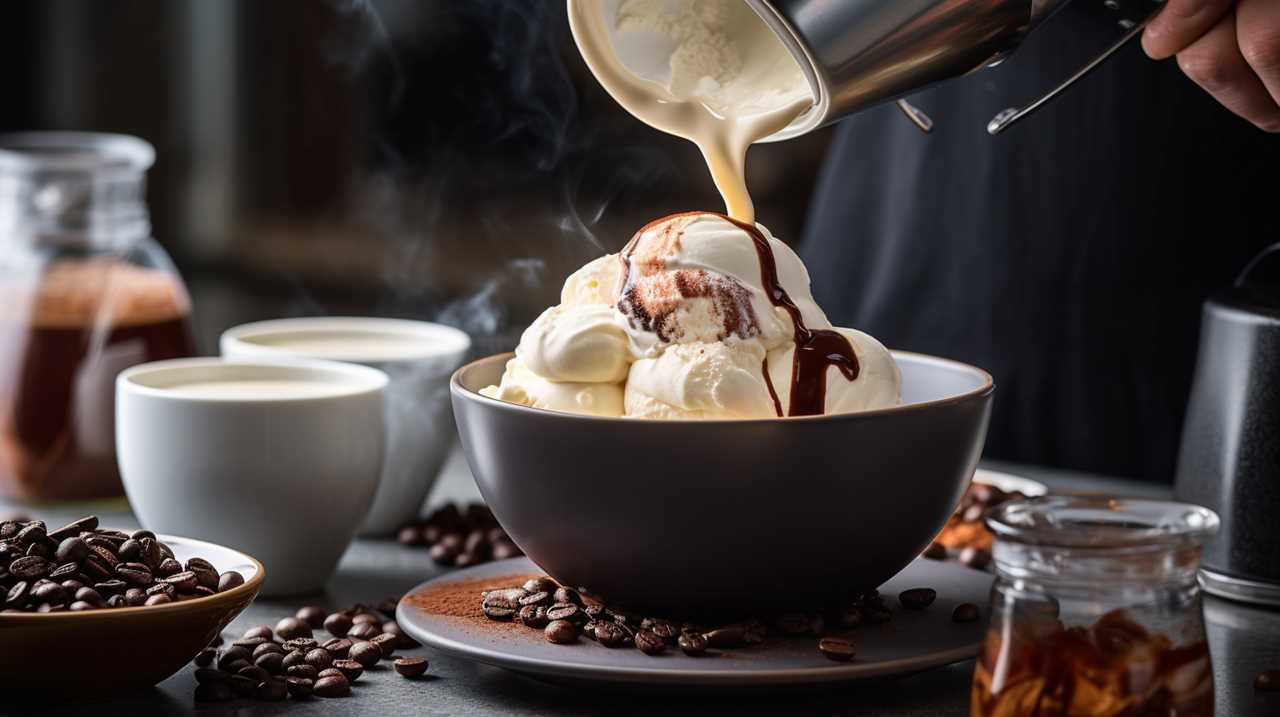
Get ready to indulge in the pure, wholesome delight of natural ice cream.
Key Takeaways
- Natural ice cream is made with simple, wholesome ingredients like milk, cream, sugar, and natural flavorings.
- It avoids artificial additives, colors, flavors, and preservatives, making it a healthier and more natural dessert option.
- Identifying natural ice cream in stores can be done by looking for labels indicating the use of natural ingredients and avoiding ice creams with artificial additives or high fructose corn syrup.
- Making natural ice cream at home allows for control over ingredients, promotes a healthier lifestyle, and encourages the use of natural sweeteners, fresh fruits, and nuts.
The Definition of Natural Ice Cream
When defining natural ice cream, we consider the ingredients used and their production methods.
Natural ice cream is made using simple, wholesome ingredients such as milk, cream, sugar, and natural flavorings. Unlike artificially flavored ice creams, natural ice cream derives its taste from real fruits, nuts, and spices. By avoiding artificial flavorings, natural ice cream offers a more authentic and satisfying taste experience.
Additionally, natural ice cream is free from artificial colors and preservatives, which can have negative health effects. Artificial ingredients often used in ice cream can lead to allergies, digestive issues, and hyperactivity in some individuals. By choosing natural ice cream, consumers can enjoy the benefits of a healthier and more natural dessert option.
Now, let’s explore the common ingredients found in natural ice cream.
Common Ingredients in Natural Ice Cream
To make natural ice cream, we use common ingredients that include milk, cream, sugar, and natural flavorings. These ingredients not only create a delicious treat but also offer numerous benefits. Here are some benefits of natural ingredients in ice cream:
- Healthier Option: Natural ingredients like milk and cream provide essential nutrients such as calcium and protein, making natural ice cream a healthier choice compared to non-natural options.
- Pure and Authentic Taste: Natural flavorings, derived from real fruits, nuts, or spices, give natural ice cream a pure and authentic taste that can’t be replicated by artificial additives.
- Fewer Allergens: Natural ice cream is often free from artificial colors, flavors, and preservatives, reducing the risk of triggering allergies or sensitivities.
- Environmentally Friendly: Choosing natural ingredients supports sustainable farming practices and reduces the environmental impact compared to non-natural ice cream production, which may rely on synthetic additives and chemicals.
In contrast, non-natural ice cream often contains artificial additives that can have negative impacts. These additives can include artificial colors, flavors, and preservatives, which may have potential health risks and lack the nutritional benefits of natural ingredients. By opting for natural ice cream, you can enjoy a guilt-free treat that’s both delicious and wholesome.
How to Identify Natural Ice Cream in the Store
To identify natural ice cream in the store, we can look for a label that indicates the use of only natural ingredients. This label could include phrases like "made with all-natural ingredients" or "no artificial flavors or colors." Additionally, it is important to read the ingredient list carefully. Natural ice cream will typically have a short list of ingredients, with recognizable items like cream, sugar, and natural flavorings. Avoid ice creams that contain artificial additives, preservatives, or high fructose corn syrup. Another helpful tip is to look for organic certifications, as organic ice cream is often made with natural ingredients. By following these guidelines, you can easily find natural ice cream in your local grocery store.
| Tips for Identifying Natural Ice Cream |
|---|
| Look for a label indicating use of natural ingredients |
| Check the ingredient list for recognizable items |
| Avoid ice creams with artificial additives or preservatives |
| Look for organic certifications |
Choosing natural ice cream has several benefits. Firstly, it is often made with higher quality ingredients, resulting in a richer and more authentic flavor. Secondly, natural ice cream is typically healthier, as it avoids artificial sweeteners and additives. Lastly, supporting brands that prioritize natural ingredients encourages sustainable and ethical practices in the food industry. So next time you’re at the store, keep an eye out for those labels and ingredient lists to enjoy the delicious and wholesome goodness of natural ice cream.
Top Natural Ice Cream Brands to Try
Now let’s explore some of the top natural ice cream brands that you should try. These brands prioritize using natural ingredients and offer a delicious and guilt-free treat. Here are four top natural ice cream brands to consider:
- Ben & Jerry’s: Known for their wide range of unique and indulgent flavors, Ben & Jerry’s offers a variety of natural ice cream options. From classics like Chocolate Fudge Brownie to innovative creations like Cherry Garcia, their flavors are made with high-quality ingredients.
- Häagen-Dazs: With a commitment to using only the finest ingredients, Häagen-Dazs delivers natural ice cream flavors that are rich and creamy. From their iconic Vanilla Bean to decadent Dulce de Leche, each flavor is carefully crafted for a delightful experience.
- Talenti: Talenti is known for their gelato, which is made with natural ingredients and traditional methods. Their flavors, such as Sea Salt Caramel and Mediterranean Mint, offer a refreshing twist on classic favorites.
- Ciao Bella: Ciao Bella creates artisanal gelato and sorbetto using natural ingredients. With flavors like Blood Orange Sorbetto and Key Lime Graham Gelato, they provide a refreshing and tangy taste experience.
The benefits of natural ice cream include the absence of artificial additives and preservatives, as well as the use of high-quality ingredients. These top natural ice cream brands prioritize sustainability and offer delicious flavors that are sure to satisfy your sweet tooth.
Making Your Own Natural Ice Cream at Home
At home, we can create our own natural ice cream using simple ingredients and a compound preposition like ‘with.’ Making vegan ice cream at home is not only a fun and creative activity, but it also allows us to control the ingredients and ensure that we are making a healthier choice. Natural ice cream is free from artificial flavors, colors, and preservatives, making it a better option for those conscious about their health. By using plant-based milk alternatives like almond, coconut, or soy milk, we can create a creamy base for our ice cream. Adding natural sweeteners like maple syrup or agave and incorporating fresh fruits or nuts can enhance the flavor and nutritional value. Below is a table that showcases the health benefits of natural ice cream compared to traditional ice cream:

| Health Benefits of Natural Ice Cream | Traditional Ice Cream |
|---|---|
| Lower in Calories | High in Calories |
| Contains Natural Ingredients | Contains Artificial Ingredients |
| Less Added Sugar | Higher Sugar Content |
| No Artificial Flavors or Colors | Artificial Flavors and Colors |
Making our own natural ice cream at home not only allows us to enjoy a guilt-free treat but also promotes a healthier lifestyle.
Frequently Asked Questions
Can Natural Ice Cream Contain Artificial Flavors or Colors?
Yes, natural ice cream can contain artificial flavors or colors. Artificial flavors in natural ice cream may help enhance taste, while artificial colors can impact the appearance. However, it’s important to check labels for transparency.
Is There a Difference in Taste Between Natural Ice Cream and Regular Ice Cream?
There is a noticeable difference in taste between natural ice cream and regular ice cream. Natural ice cream tends to have a richer, creamier flavor due to the higher quality ingredients and lack of artificial additives.
What Is the Shelf Life of Natural Ice Cream?
The shelf life of natural ice cream can vary depending on the preservation methods used. Properly stored, it can typically last for several months. However, it’s always best to check the expiration date for the most accurate information.
Are There Any Health Benefits to Consuming Natural Ice Cream?
There can be health benefits to consuming natural ice cream. It typically has higher nutritional value due to the use of real ingredients like fruit and nuts. However, moderation is key for a balanced diet.
Can Natural Ice Cream Be Enjoyed by People With Lactose Intolerance or Other Dietary Restrictions?
Natural ice cream alternatives, like lactose-free options, can be enjoyed by those with lactose intolerance or dietary restrictions. These options provide a satisfying and delicious experience, ensuring that everyone can indulge in the creamy goodness of ice cream.
Are Any of Dairy Queen’s Ice Cream Flavors All-Natural?
Yes, Dairy Queen’s ice cream flavors are made with all-natural ingredients. You can enjoy classic options like chocolate, vanilla, and strawberry, or try one of their unique creations like Oreo, Reeses, or cotton candy. Dairy Queen is committed to providing delicious, high-quality treats using only the best ingredients.
Conclusion
In conclusion, when it comes to natural ice cream, it’s important to read labels and look for brands that use simple, wholesome ingredients. By doing so, you can enjoy a delicious treat that’s free from artificial additives and preservatives.
Remember the saying, ‘nature knows best,’ and opt for natural ice cream to indulge in a truly authentic and flavorful experience.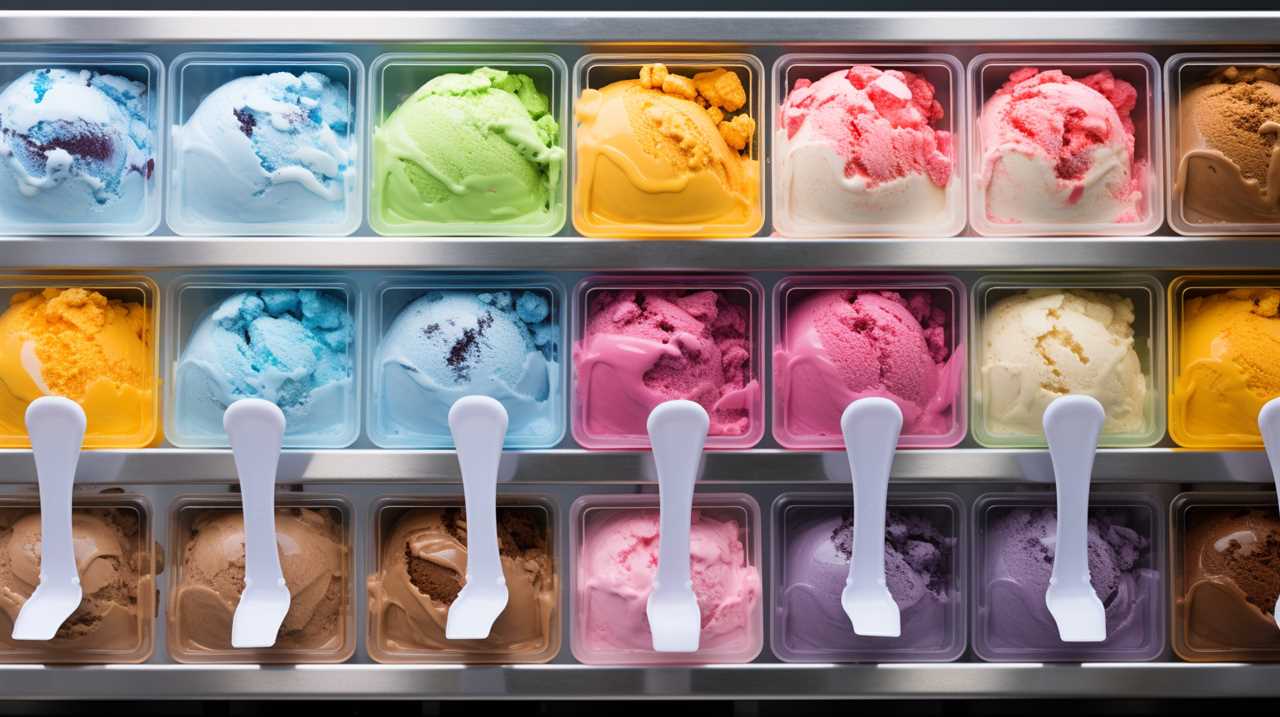
Beyond the realm of flavor and technique, Adriano recognizes the importance of sustainability and conscious consumption. His writing often explores eco-friendly practices within the ice cream industry, highlighting the use of locally sourced ingredients, reducing waste, and supporting ethical production methods.
Ice Cream Toppings
What Is an Ice Cream Taster
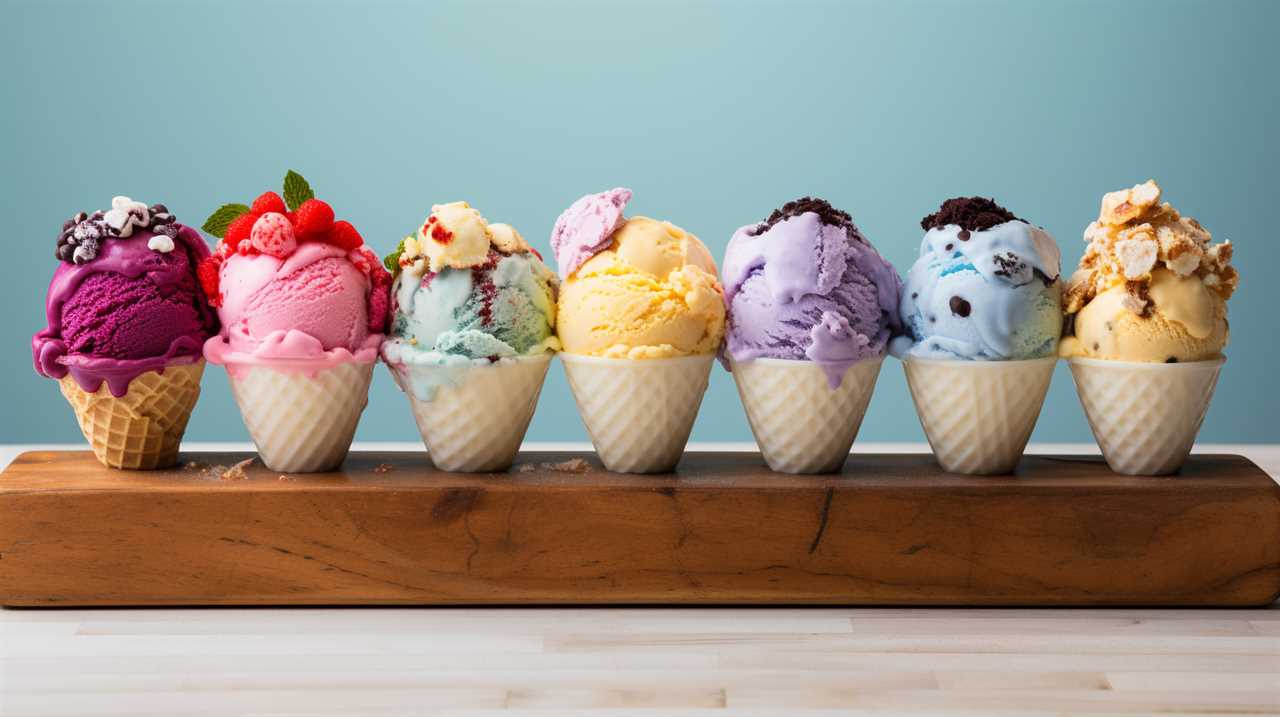
Greetings, ice cream aficionados! Ever wondered what it’s like to taste ice cream for a living? Worry no more, we’ve gathered all the necessary details for you.
In this article, we’re going to dive into the delicious world of ice cream tasting. We’ll explore the responsibilities, skills, and qualifications needed for this dream job, as well as the training process and the perks and challenges that come with it.
So, grab a spoon and get ready to discover the scoop on being an ice cream taster!
Key Takeaways
- An ice cream taster is responsible for evaluating the taste, texture, and quality of ice cream flavors, and they use taste testing and flavor profiling techniques.
- They must have a refined sense of taste and keen sense of smell, as well as training and education in food science or a related field. A formal certification in sensory evaluation is preferred.
- The training and education process for ice cream tasters involves comprehensive instruction, hands-on practice, and guidance from professionals to develop their sensory analysis skills.
- While there are challenges, such as the potential health issues from constant ice cream consumption, the benefits of being an ice cream taster include enjoying different ice cream flavors and appreciating the artistry and craftsmanship in ice cream making.
The Responsibilities of an Ice Cream Taster
Our responsibilities as ice cream tasters include evaluating the taste, texture, and quality of various ice cream flavors. To ensure accuracy and consistency in our evaluations, we employ a range of taste testing techniques and flavor profiling techniques.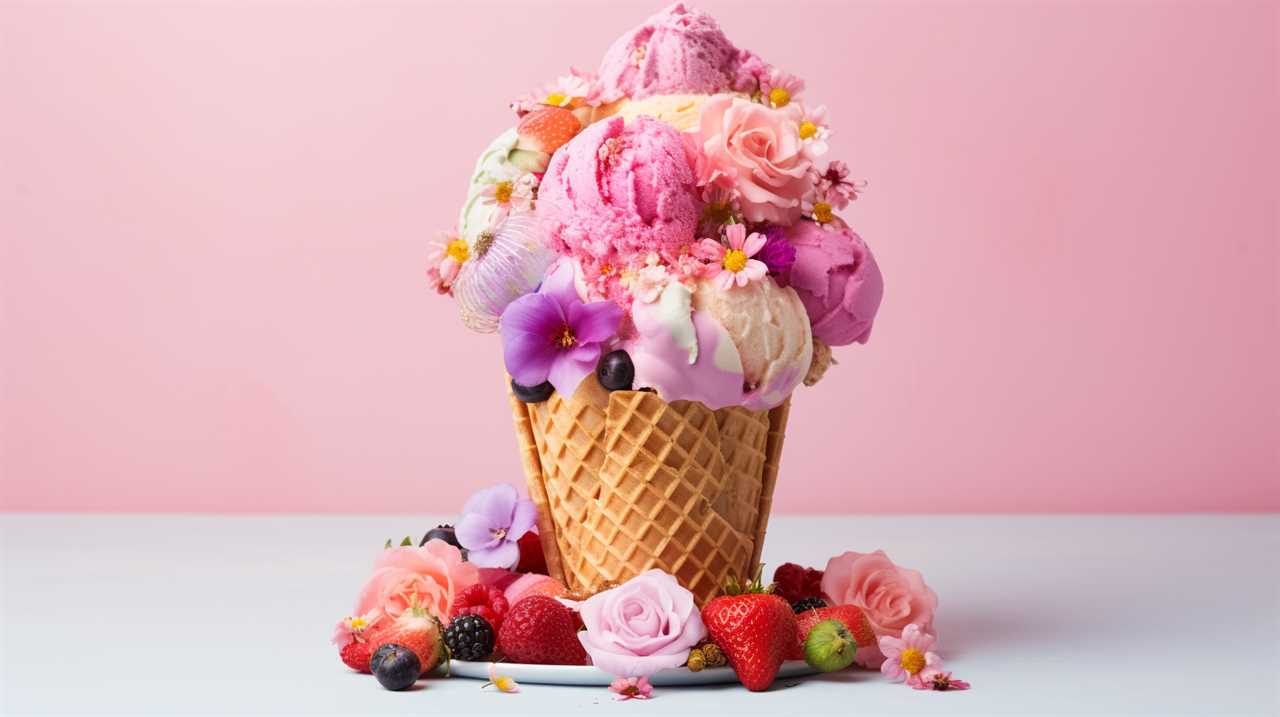
When it comes to taste testing, we use our senses to assess the flavor intensity, sweetness, and balance of each ice cream sample. We pay close attention to the texture, noting whether it’s smooth, creamy, or too icy.
Furthermore, we evaluate the quality of the ingredients used, considering factors such as freshness and flavor complexity. Through our objective and analytical approach, we’re able to provide valuable insights that help ice cream makers create the most delectable and satisfying frozen treats.
The Skills and Qualifications Needed
To become an ice cream taster, we must possess certain skills and qualifications. While it may seem like a dream job, it requires more than just a love for ice cream.
First and foremost, a refined sense of taste is essential. Ice cream tasters must be able to detect subtle flavors and nuances in different varieties. Additionally, they must have a keen sense of smell, as aroma plays a significant role in the overall taste experience.
Training and education in food science or a related field is often preferred, as it provides a deeper understanding of the science behind ice cream production. Some companies may also require a formal certification in sensory evaluation.
Ultimately, a combination of natural talent, training, and a passion for ice cream is what sets a successful ice cream taster apart.
The Training and Education Process
One important step in becoming an ice cream taster is completing a comprehensive training and education process. The training techniques used in this process are designed to develop and refine the taster’s sensory analysis skills.
Through a combination of classroom instruction, hands-on practice, and guidance from experienced professionals, aspiring ice cream tasters learn to discern the subtle nuances in flavor, texture, and aroma that make each scoop unique. They’re taught how to evaluate the quality and consistency of the ice cream, identify any defects or inconsistencies, and provide valuable feedback to ensure that only the best products make it to market.
This training process equips ice cream tasters with the knowledge and expertise necessary to confidently assess and critique ice cream flavors, helping to maintain the high standards of the industry.
The Benefits and Challenges of the Job
Ice cream tasting offers both enjoyable benefits and unique challenges.
One of the main benefits of this job is the sheer pleasure of indulging in different flavors and varieties of ice cream. As an ice cream taster, we get to experience the delightful taste and creamy texture of various ice cream creations. This not only satisfies our taste buds but also allows us to appreciate the artistry and craftsmanship that goes into making each batch.
However, there are also challenges that come with the job. One of the biggest challenges is maintaining objectivity while tasting. It can be difficult to remain unbiased and evaluate each sample based on its merits alone. Additionally, constantly consuming ice cream can take a toll on our health, as it can lead to weight gain and other health issues.
Despite these challenges, the benefits of being an ice cream taster often outweigh the drawbacks, as we get to enjoy the sweet rewards of our labor.
The Future Outlook for Ice Cream Tasters
As we look ahead to the future of ice cream tasting, it’s important to consider the evolving trends and advancements in the industry. Here are some key factors that will shape the future outlook for ice cream tasters:
- Increasing demand for unique flavors and innovative combinations will require tasters to constantly explore new taste profiles and provide feedback on potential market hits.
- The rise of health-conscious consumers will lead to a growing demand for healthier alternatives, such as low-fat, dairy-free, and plant-based options. Tasters will play a crucial role in ensuring that these products meet the taste expectations of consumers.
- With the advent of technology, there may be a shift towards virtual tastings, allowing tasters to evaluate ice cream samples remotely. This will provide opportunities for tasters to work with a wider range of brands and products.
- Sustainability will become a key focus in the ice cream industry, and tasters will be expected to evaluate not just taste, but also the environmental impact of production processes.
The future of ice cream tasting is filled with exciting opportunities and challenges as the market demand and consumer preferences continue to evolve. Tasters will need to adapt and embrace these changes to stay relevant in the industry.
Frequently Asked Questions
How Many Different Flavors of Ice Cream Does an Ice Cream Taster Typically Sample in a Day?
On average, we sample a wide variety of ice cream flavors daily as tasters. Our role in product development allows us to provide valuable insights and feedback, ensuring the best flavors make it to market.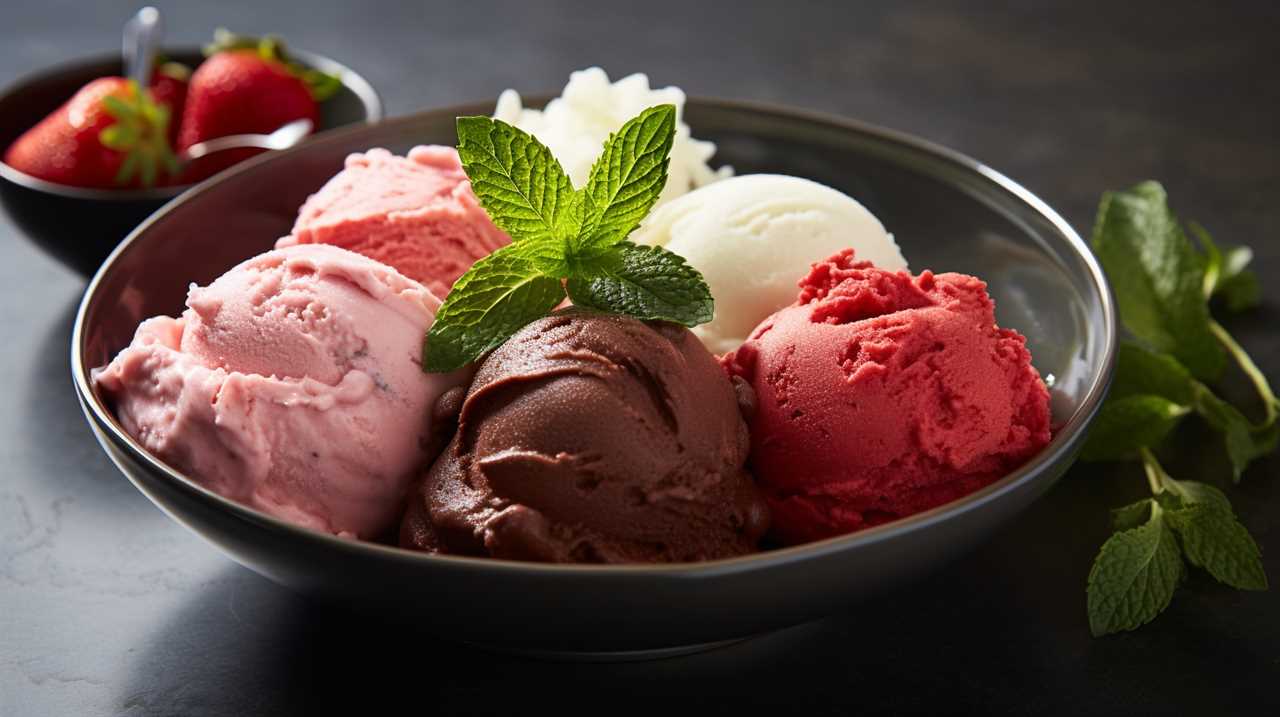
Is There a Specific Age Requirement to Become an Ice Cream Taster?
There’s no specific age requirement to become an ice cream taster, but there are certain qualifications and training required. We’ll explore the details and what it takes to become a professional ice cream taster.
Are There Any Dietary Restrictions or Allergies That Could Disqualify Someone From Being an Ice Cream Taster?
Dietary restrictions or allergies may disqualify potential ice cream tasters. Age requirements vary, but expertise in flavor profiling and analysis is essential. Salary range is typically competitive, reflecting the qualifications needed for this role.
What Is the Average Salary Range for Ice Cream Tasters?
The average salary range for ice cream tasters is highly dependent on factors such as experience, location, and employer. However, we can expect a competitive compensation package for this delicious job.
Is There a Certain Level of Expertise Needed in Terms of Flavor Profiling and Analysis to Become an Ice Cream Taster?
Flavor profiling techniques are essential for ice cream tasters. Training for ice cream tasting involves developing a refined palate to analyze and evaluate flavors. It requires expertise to discern subtle nuances and provide objective feedback.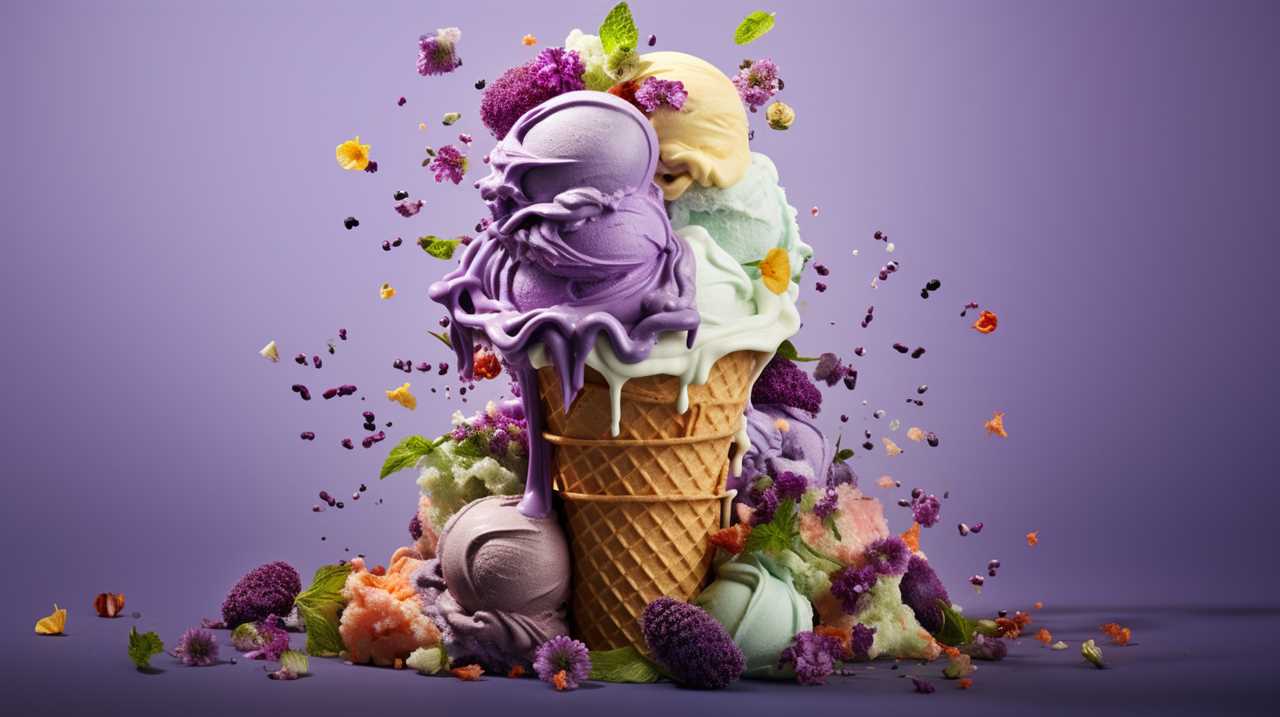
Can an Ice Cream Taster Help Determine the Icy Taste of My Ice Cream?
Yes, an ice cream taster can certainly help determine the icy taste of your ice cream. They are trained to identify the specific texture and flavor components that may contribute to an icy consistency. If you want to know how to fix icy ice cream, consulting an expert taster could provide valuable insights.
Conclusion
In conclusion, being an ice cream taster is a dream come true for any dessert enthusiast.
The responsibilities, skills, and qualifications required for the job are crucial in ensuring the highest quality of ice cream.
While the training and education process may be challenging, the benefits of indulging in countless flavors and experiencing the joy of taste make it all worthwhile.
As the future outlook for ice cream tasters remains sweet, this job offers a delightful path for those seeking a delicious career.
Beyond the realm of flavor and technique, Adriano recognizes the importance of sustainability and conscious consumption. His writing often explores eco-friendly practices within the ice cream industry, highlighting the use of locally sourced ingredients, reducing waste, and supporting ethical production methods.
Ice Cream Toppings
Where Ice Cream Invented

Ever curious about the origins of the smooth and delightful dessert known as ice cream? Get ready for a voyage back in time as we delve into the historical beginnings, initial variations, cultural evolutions, and European impact on this beloved cold indulgence.
Join us as we delve into the fascinating history of ice cream, uncovering the secrets behind its creation and discovering the modern innovations that continue to tantalize our taste buds.
Get ready to scoop up some knowledge and satisfy your curiosity!
Key Takeaways
- Ice cream originated in China during the 5th century BC and was initially enjoyed by the wealthy elite.
- Marco Polo introduced ice cream to Europe in the 13th century, where it quickly gained popularity among the nobility.
- Cultural adaptations in different countries, such as Italy, Japan, and India, resulted in the development of unique variations of ice cream.
- Technological advancements have revolutionized the ice cream industry, leading to improved taste and texture, as well as the availability of customizable flavors and healthier options.
Ancient Origins
We have discovered that the ancient origins of ice cream can be traced back to at least the 5th century BC in China. Historical evidence suggests that the Chinese were the first to create a dairy-based frozen dessert. During the Tang Dynasty (618-907 AD), it was common for the wealthy to enjoy a frozen mixture of buffalo milk, flour, and camphor. This early version of ice cream was a delicacy reserved for the elite.
From China, the love for frozen treats gradually spread to other parts of Asia and the Middle East. By the 13th century, Marco Polo had introduced ice cream to Europe, where it quickly gained popularity among the nobility. The global spread of ice cream continued throughout history, evolving and adapting to different cultures and tastes.
As we move forward to explore the early variations of ice cream, it’s fascinating to see how this frozen delight has transformed over time.
Early Variations
The early variations of ice cream encompassed a diverse range of flavors and ingredients. People in different regions and cultures experimented with various combinations to create unique frozen treats. Some predecessor flavors and historical recipes include:
- Fruit-infused ice creams: These were made by combining crushed fruit with sugar and cream, resulting in a refreshing and fruity dessert.
- Spiced ice creams: Some cultures added spices like cinnamon, nutmeg, or cardamom to their ice cream, giving it a warm and aromatic twist.
- Floral ice creams: Using flowers such as lavender or rose petals, these ice creams offered a delicate and fragrant flavor.
- Nut-based ice creams: Ground almonds or pistachios were mixed with cream and sugar, creating a rich and nutty dessert.
As ice cream continued to evolve, these early variations laid the foundation for cultural adaptations, which we’ll explore next.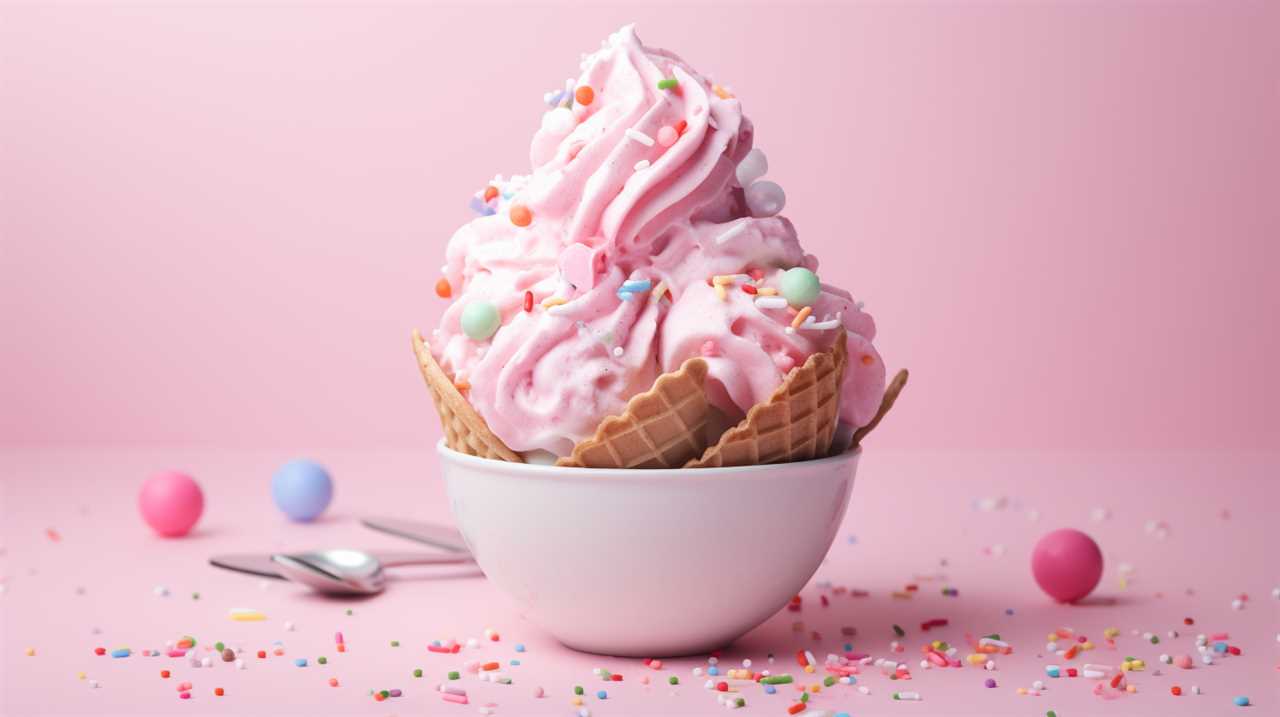
Cultural Adaptations
As ice cream continued to evolve, the diverse range of flavors and ingredients in early variations laid the foundation for cultural adaptations. Cultural assimilation played a significant role in shaping the different adaptations of ice cream around the world. Each region developed its own unique preferences, incorporating local ingredients and techniques to create distinct flavors and styles. To illustrate this, let’s take a look at three examples of cultural adaptations of ice cream:
| Region | Flavor | Cultural Adaptation |
|---|---|---|
| Italy | Gelato | Creamier and denser texture, made with less air and fat |
| Japan | Mochi ice cream | Ice cream wrapped in sweet rice cake |
| India | Kulfi | Made with condensed milk, flavored with cardamom and nuts |
These regional preferences showcase the influence of local tastes and culinary traditions on ice cream. Cultural adaptations not only highlight the versatility of ice cream but also provide a glimpse into the cultural richness of different societies.
European Influence
Continuing from our exploration of cultural adaptations, the European influence on ice cream can’t be understated. Europeans played a significant role in shaping the flavors and popularity of ice cream as we know it today. Here are some key ways in which they influenced this frozen treat:
- Introduction of new flavors: European countries like Italy and France introduced unique flavors such as pistachio, hazelnut, and lavender, expanding the range of options beyond traditional fruit flavors.
- Development of gelato: Italian gelato, with its creamy texture and intense flavors, became immensely popular across Europe and eventually spread to other parts of the world.
- Creation of ice cream parlors: European cities saw the rise of ice cream parlors, providing a dedicated space for people to indulge in this delightful treat.
- Adoption by royalty: Ice cream gained prestige and popularity when European royalty, including Queen Catherine de’ Medici of France, became avid consumers.
Through these contributions, Europeans shaped the flavors and culture surrounding ice cream, leaving a lasting impact on its enjoyment worldwide.
Modern Innovations
After exploring the European influence on ice cream, we can now delve into modern innovations that have shaped this frozen treat. In recent years, there have been significant advancements and technological improvements that have revolutionized the ice cream industry. These innovations have not only improved the taste and texture of ice cream but have also made it more accessible and customizable for consumers.
One major advancement is the development of commercial ice cream machines. These machines have streamlined the production process, allowing for faster and more efficient manufacturing. They also ensure consistent quality and texture, resulting in a smoother and creamier ice cream experience.
Furthermore, there have been advancements in ice cream flavors and ingredients. With the use of new technologies, manufacturers can create unique and exotic flavors, as well as cater to specific dietary needs such as lactose-free or vegan options. Additionally, there have been improvements in the use of natural and organic ingredients, offering a healthier alternative to traditional ice cream.
Lastly, the invention of liquid nitrogen ice cream has taken the dessert world by storm. This innovative technique involves freezing the ice cream mixture with liquid nitrogen, resulting in a creamy and smooth texture. It also allows for on-demand preparation, giving customers a fresh and personalized experience.

Overall, these advancements and technological improvements have not only enhanced the ice cream industry but have also elevated the consumer’s ice cream experience. With the constant drive for innovation, we can expect even more exciting developments in the future of ice cream.
| Advancements | Technological Improvements |
|---|---|
| Commercial ice cream machines | Streamlined production process, consistent quality |
| Unique and exotic flavors | New technologies for flavor creation |
| Catering to specific dietary needs | Use of natural and organic ingredients |
| Liquid nitrogen ice cream | Fresh and personalized experience with on-demand preparation |
Frequently Asked Questions
How Is Ice Cream Made?
Ice cream is made by combining milk, cream, sugar, and flavorings, then freezing the mixture while stirring. There are various types of ice cream machines that can be used in the production process.
What Are the Nutritional Values of Ice Cream?
Ice cream is a delicious treat, but it’s important to be mindful of its nutritional values. Did you know that a 1/2 cup serving of vanilla ice cream contains about 137 calories? If you’re looking for alternatives, consider frozen yogurt or sorbet.
What Are Some Popular Ice Cream Flavors?
Most iconic ice cream flavors include chocolate, vanilla, and strawberry. Unique ice cream flavors, like matcha or lavender, offer a delightful twist. These flavors, with their rich and diverse tastes, are beloved by ice cream enthusiasts around the world.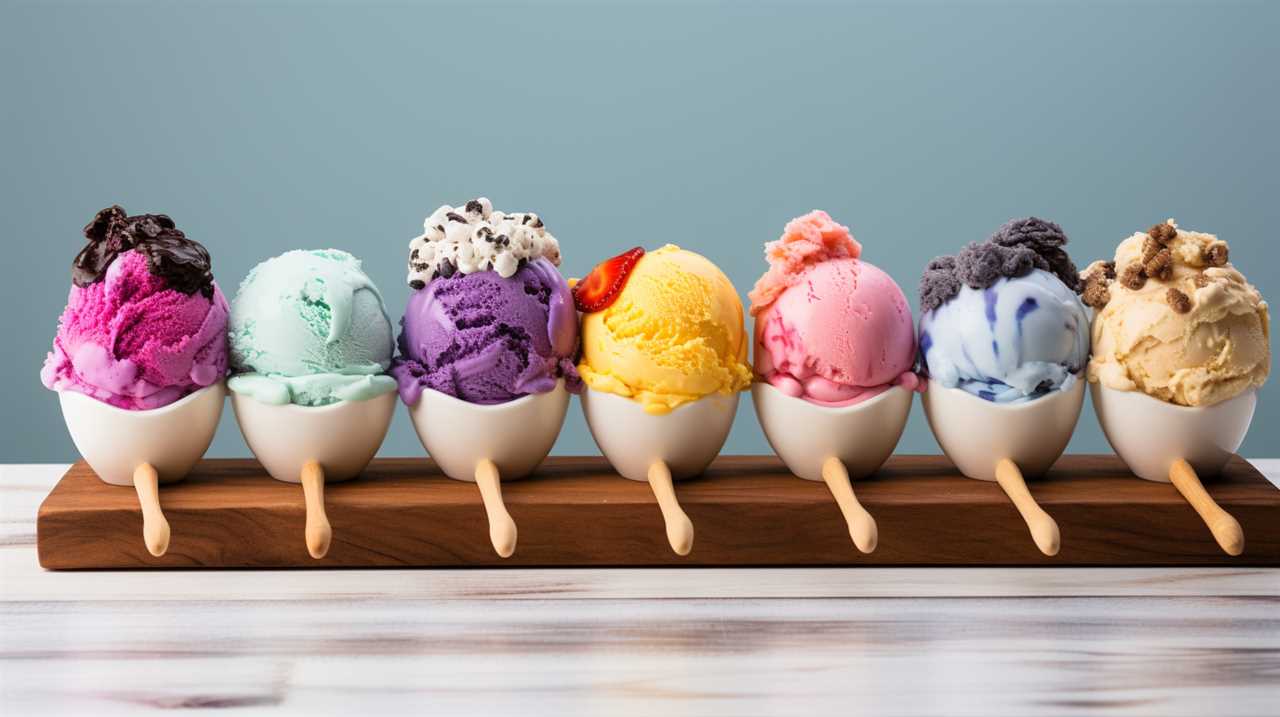
How Has the Ice Cream Industry Evolved Over Time?
Over time, the ice cream industry has evolved in various ways. We have seen significant changes in ice cream marketing, with creative strategies and personalized experiences. Additionally, technology has greatly impacted ice cream production, leading to improved quality and efficiency.
What Are the Health Benefits and Risks Associated With Consuming Ice Cream?
When it comes to ice cream, we all crave that creamy, indulgent treat. But it’s important to be aware of the health risks, like lactose intolerance, that can come with consuming it.
Where Was Ice Cream Invented?
The ice cream origins unveiled point to a long history, with evidence of frozen treats dating back to ancient civilizations. Some theories suggest that the Chinese were the first to invent a primitive form of ice cream, while others credit the Persians with its creation.
Conclusion
In conclusion, the origins of ice cream can be traced back to ancient times, with early variations emerging across different cultures. European influence played a significant role in the development of this delicious treat, leading to modern innovations that we enjoy today.
Ice cream, like a delightful symphony of flavors, has evolved over the centuries, captivating our taste buds with its creamy textures and delightful sweetness. Its journey is a testament to human creativity and the universal love for indulgence.
Beyond the realm of flavor and technique, Adriano recognizes the importance of sustainability and conscious consumption. His writing often explores eco-friendly practices within the ice cream industry, highlighting the use of locally sourced ingredients, reducing waste, and supporting ethical production methods.
Ice Cream Toppings
What Is Ice Cream Mean

Ice cream serves as a delightful indulgence that delights our palates, offering a delicious retreat from the everyday. It beckons with the allure of luxury, stirring up nostalgic thoughts of unconcerned summer days and fingers covered in sweetness. Yet, what is its real significance to us?
Beyond the creamy texture and delightful flavors, ice cream holds cultural significance, scientific marvels, and a nostalgic power that transcends time. It is more than just a dessert. It is a symbol of celebration, a centerpiece at birthday parties and weddings. It is a way for families to bond, gathering around the kitchen table to share a scoop or two. It is a treat that brings people together, creating moments of pure happiness.
Ice cream has also been a source of fascination for scientists. The process of making ice cream involves a delicate balance of ingredients and techniques to achieve the perfect texture and taste. The science behind freezing and churning the mixture to create ice crystals of the right size is a marvel in itself. But it doesn’t stop there. Ice cream makers are constantly experimenting with new flavors and techniques, pushing the boundaries of what is possible.
And then there is the nostalgia that ice cream holds. It takes us back to our childhood, to hot summer days spent chasing after the ice cream truck. It reminds us of simpler times, when a cone filled with our favorite flavor was all we needed to be happy. Even as adults, a scoop of ice cream can transport us back to those carefree moments, if only for a few bites.
So join us as we delve into the world of ice cream, exploring its history, significance, and the sheer pleasure it brings to our lives. From the ancient origins of frozen desserts to the modern-day innovations, let’s uncover the secrets behind this beloved treat. Let’s celebrate the joy of ice cream together.
Key Takeaways
- Ice cream has a rich history and cultural significance, with various flavors enjoyed in different cuisines around the world.
- The science behind ice cream involves the combination of ingredients, temperature control, and the use of emulsifiers and stabilizers to achieve the desired texture.
- Ice cream is associated with childhood memories and evokes feelings of nostalgia and joy.
- The pleasure of ice cream lies in its sensory experience, including the creamy texture, explosion of flavors, and the comforting feeling it provides on a hot day.
A Brief History of Ice Cream
Let’s delve into the fascinating history of ice cream and discover its origins. Ice cream has come a long way since its humble beginnings. Over the years, we’ve witnessed the evolution of ice cream flavors, from classic vanilla and chocolate to unique and exotic combinations like salted caramel and lavender. These flavors have been created to tantalize our taste buds and provide us with a delightful sensory experience.
But ice cream isn’t just about the flavors; it has also served as a symbol of luxury and status throughout history. In ancient times, only the wealthy could afford this frozen treat, as it required expensive ingredients and labor-intensive processes.
Today, ice cream continues to hold a special place in our hearts, not only for its delicious taste but also for the memories and emotions it evokes. Now, let’s explore the cultural significance of ice cream and how it has become ingrained in our lives.
Cultural Significance of Ice Cream
Ice cream holds a significant place in our culture, influencing our traditions, celebrations, and everyday indulgences. It is a dessert that transcends borders and is loved by people all over the world. Different cultures have their own unique ways of incorporating ice cream into their culinary traditions. Let’s take a look at how ice cream is enjoyed in different cuisines:
| Cuisine | Ice Cream Flavor | Cultural Tradition |
|---|---|---|
| Italian | Pistachio | Gelato is a staple in Italian cuisine. It is often enjoyed as a refreshing treat during hot summer days. |
| Japanese | Matcha | Green tea flavored ice cream is a popular choice in Japan. It is often served as a dessert after meals. |
| American | Vanilla | Classic vanilla ice cream is a versatile base for various toppings and is enjoyed at birthday parties and summer barbecues. |
| Indian | Mango | Mango is a beloved fruit in India, and mango-flavored ice cream, known as "kulfi," is a popular dessert during festivals and celebrations. |
| Mexican | Tres Leches | Tres Leches ice cream is inspired by the traditional Mexican cake and is enjoyed as a sweet treat after meals or during festive occasions. |
These cultural traditions demonstrate the diverse ways in which ice cream is incorporated into different cuisines, adding a touch of sweetness and joy to people’s lives. Now, let’s delve into the science behind this delectable dessert.
The Science Behind Ice Cream
Now, we’ll explore the fascinating scientific principles that contribute to the creation of this beloved frozen treat.
- Ice Cream Manufacturing Process: Ice cream is made by combining ingredients such as milk, sugar, and flavorings, and then freezing the mixture. This process involves churning the mixture to incorporate air and create a creamy texture.
- Temperature and Texture: The role of temperature is crucial in determining the texture of ice cream. When the mixture is churned and frozen at the right temperature, it forms small ice crystals, resulting in a smooth and creamy texture. If the temperature is too low, the ice cream can become hard and icy, while if it’s too high, it can become grainy.
- Emulsifiers and Stabilizers: Emulsifiers and stabilizers are often added to ice cream to improve its texture and prevent the formation of ice crystals. These ingredients help to bind fat and water molecules together, resulting in a smoother and more stable product.
- Overrun: Overrun refers to the increase in volume that occurs during the freezing process. It’s achieved by incorporating air into the ice cream mixture. The amount of overrun affects the texture and mouthfeel of the final product, with higher overrun resulting in a lighter and fluffier texture.
- Freezing Technique: The rate at which ice cream is frozen also affects its texture. Quick freezing techniques, such as using liquid nitrogen, can result in smaller ice crystals, leading to a smoother and creamier ice cream.
Understanding the science behind ice cream production allows us to appreciate the artistry and precision involved in creating this frozen delight. From the delicate balance of ingredients to the careful control of temperature, every step contributes to the creation of a perfect scoop of ice cream.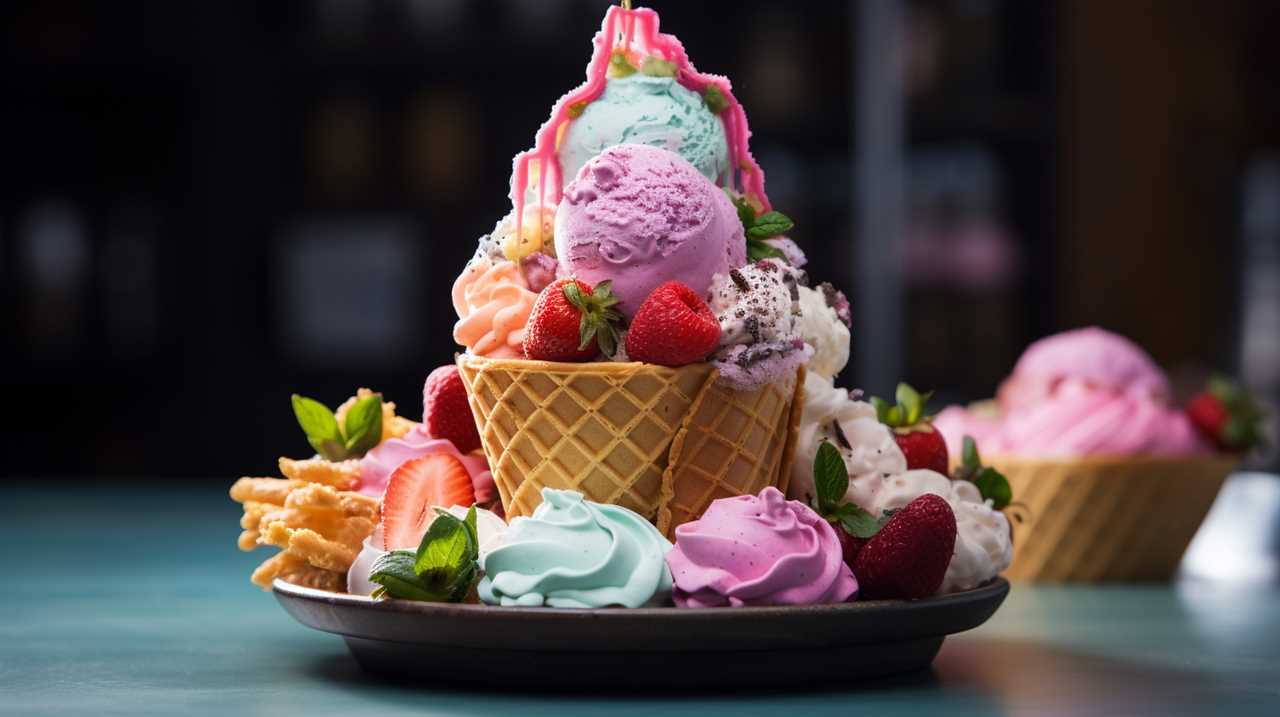
Ice Cream and Childhood Memories
As we delve into the realm of ice cream and childhood memories, we can’t help but reminisce about the joyous moments that were shared with friends and family over a scoop of this delectable treat.
The nostalgic flavors of our favorite ice creams transport us back to carefree days filled with laughter and sunshine.
We can still hear the familiar jingle of the ice cream truck coming down the street, its arrival signaling an adventure waiting to be had.
Running barefoot, we’d eagerly line up, clutching our coins, ready to indulge in a frozen delight.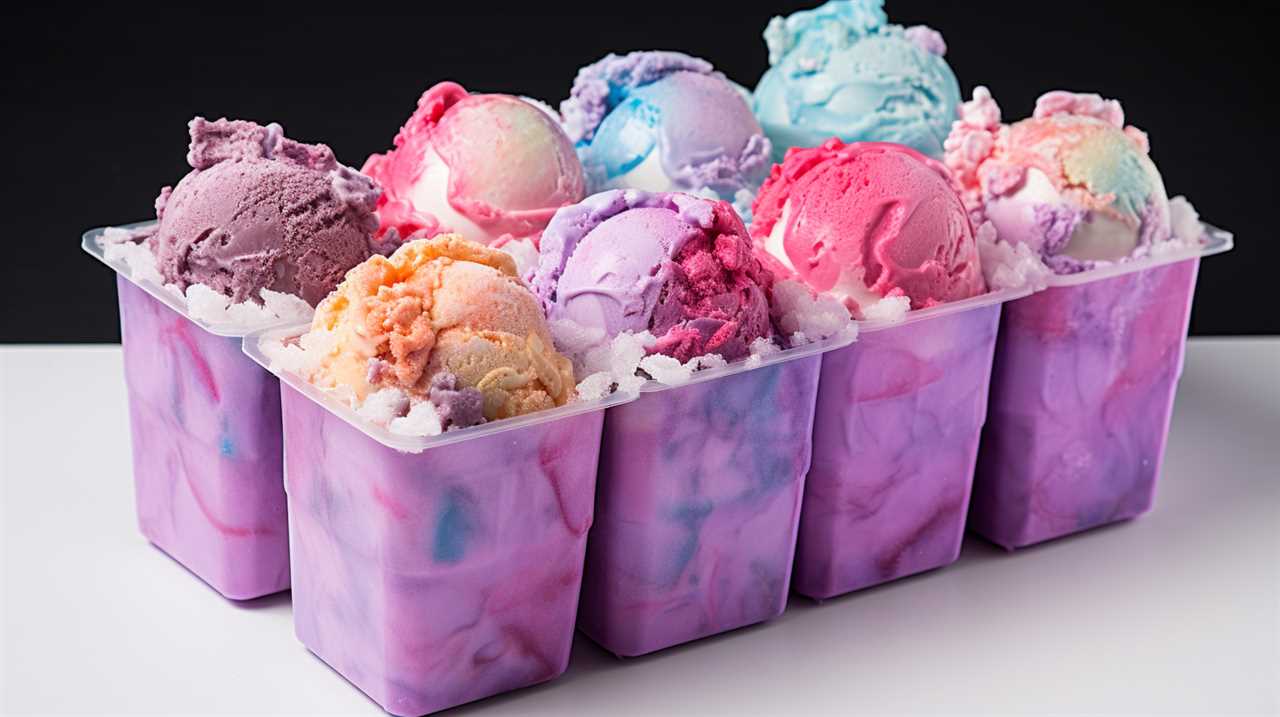
The anticipation of choosing from a variety of flavors was almost as exciting as the first lick.
These ice cream truck adventures created lasting memories that we still cherish today, reminding us of the simple joys of childhood.
The Pleasure of Indulging in Ice Cream
Indulging in ice cream brings us immense pleasure and a sense of pure bliss. There’s something about the creamy texture and the sweet, cold taste that instantly transports us to a world of pure delight. As we take that first spoonful, a sensory experience unfolds, captivating our taste buds and tantalizing our senses.
Here are five reasons why indulging in ice cream is such a joyous experience:
- The velvety smoothness of the ice cream as it melts in our mouths.
- The explosion of flavors that dance on our tongues, from classic vanilla to decadent chocolate chip cookie dough.
- The comforting feeling of a cold treat on a hot summer day, instantly cooling us down.
- The nostalgia it brings, evoking memories of carefree childhood days spent chasing the ice cream truck.
- The surprising health benefits, like the calcium and protein it provides, and the mood-boosting effects it can have.
Frequently Asked Questions
How Many Calories Are in a Typical Serving of Ice Cream?
A typical serving of ice cream contains varying calorie content depending on the flavor and brand. It’s important to check the nutrition label for accurate information. Serving size also plays a role in determining the overall calorie intake.
What Are Some Common Ingredients Used to Make Ice Cream?
Ice cream flavors are diverse, offering a wide range of taste experiences. There are endless variations in ice cream recipes, allowing for unique combinations of ingredients that tantalize our taste buds.
Are There Any Health Benefits to Eating Ice Cream?
Eating ice cream can be a delightful treat. We’ve found that different flavors offer varying nutritional values. While it may not directly aid in weight management, moderation allows us to enjoy this indulgence guilt-free.
Can Lactose-Intolerant Individuals Still Enjoy Ice Cream?
Yes, lactose-intolerant individuals can still enjoy ice cream! There are many lactose-free alternatives available that taste just as delicious. Some favorite flavors for those with lactose intolerance include coconut milk-based and sorbet options.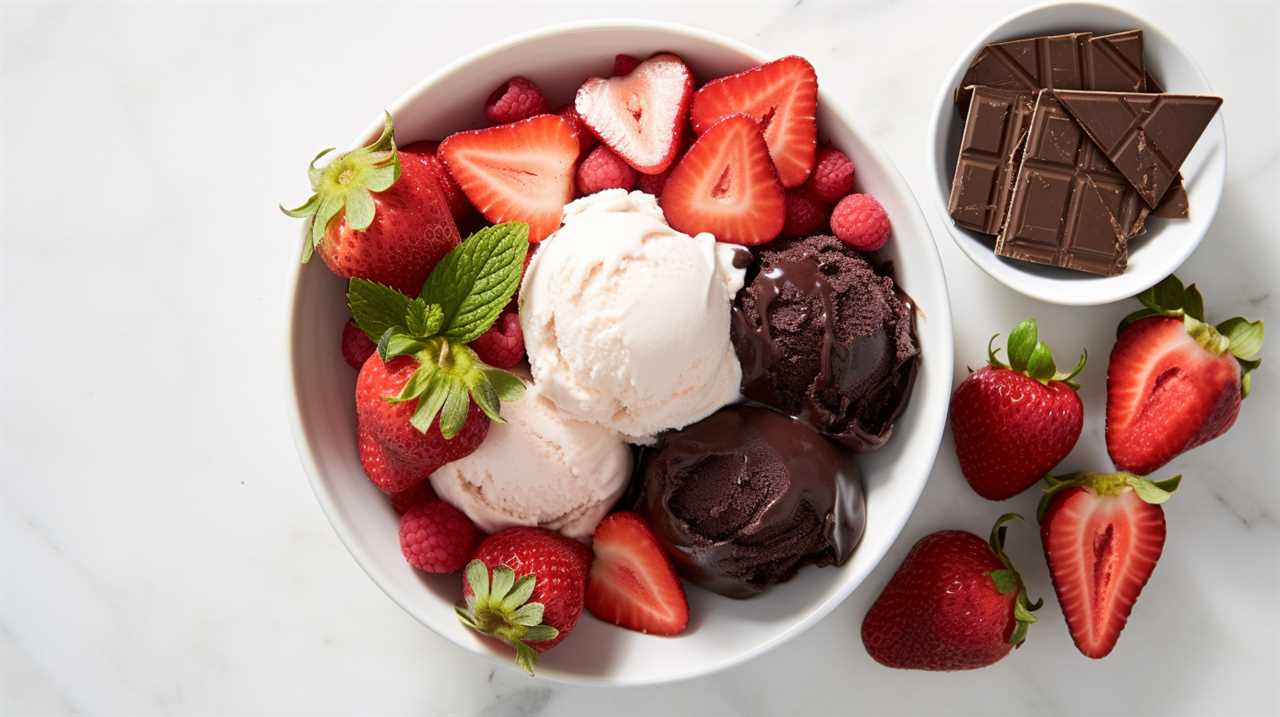
Is It Possible to Make Homemade Ice Cream Without an Ice Cream Maker?
Making homemade ice cream without an ice cream maker is totally doable! We’ve got you covered with delicious recipes and handy tips. Get ready to indulge in creamy, dreamy treats right from your own kitchen. Let’s get churning!
What Are Some Health Risks Associated with Eating Ice Cream?
Some side effects of ice cream consumption include weight gain from high sugar and fat content, increased risk of diabetes due to insulin resistance, and potential digestive issues from lactose intolerance. Eating ice cream in moderation and choosing lower-fat options can help mitigate these health risks.
Conclusion
And so, as we reach the end of our icy journey through the world of ice cream, we’re left with a bittersweet realization.
In this frozen treat lies a hidden truth – that indulging in the pleasure of ice cream isn’t just about satisfying our taste buds, but also about relishing in the nostalgia of childhood and the simple joys of life.
So next time you savor that scoop of creamy goodness, remember that ice cream holds within it the power to transport us back to a time of innocence and happiness.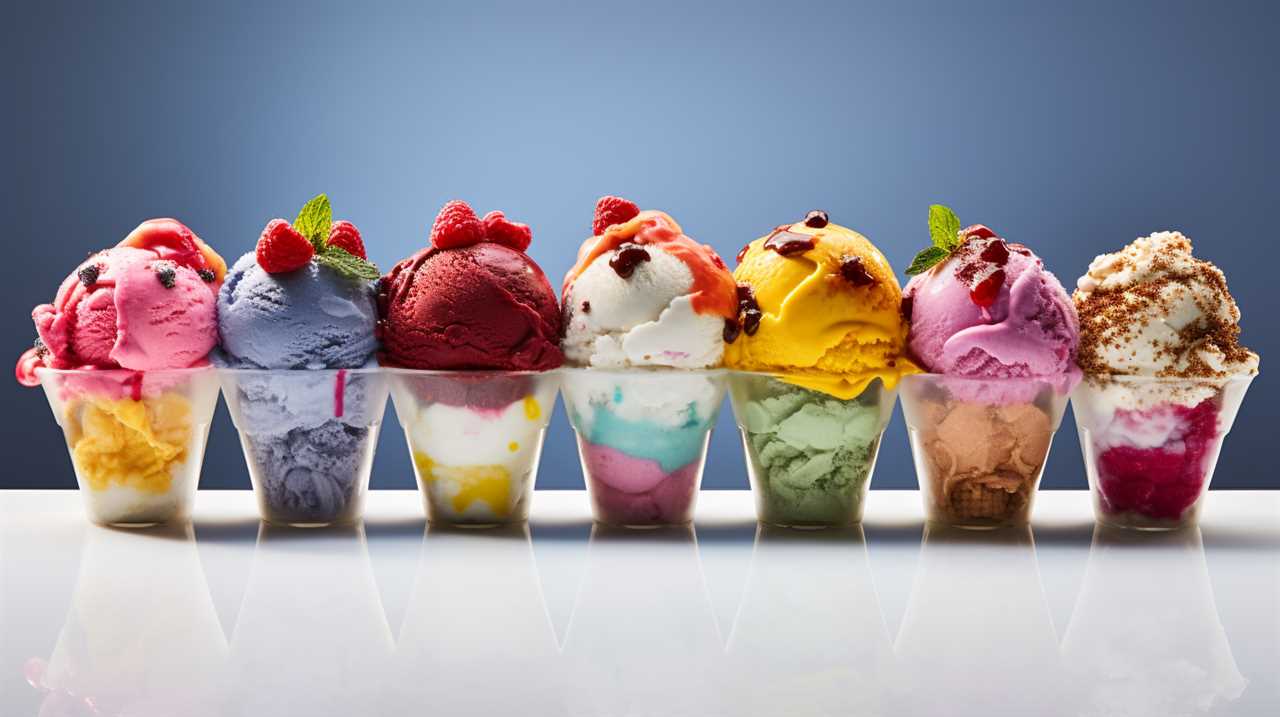
Beyond the realm of flavor and technique, Adriano recognizes the importance of sustainability and conscious consumption. His writing often explores eco-friendly practices within the ice cream industry, highlighting the use of locally sourced ingredients, reducing waste, and supporting ethical production methods.
-

 Beginners Guides3 weeks ago
Beginners Guides3 weeks agoCreamy Remedies: Good Ice Cream Choices for Acid Reflux Relief
-

 Beginners Guides3 weeks ago
Beginners Guides3 weeks agoHow to Do When Your Ice Cream Tastes Gritty: Quick Fixes
-
Beginners Guides2 weeks ago
10 Differences Between Ice Cream and Popsicles
-

 About Ice Cream4 days ago
About Ice Cream4 days agoWhat Military Diet Rules Allow Ice Cream?
-

 Creative Ice Cream Recipes3 weeks ago
Creative Ice Cream Recipes3 weeks agoWho Makes Dairy Queen Ice Cream
-

 About Ice Cream4 days ago
About Ice Cream4 days ago10 Reasons Why You Feel Like Throwing Up When You Eat Ice Cream
-

 Start your own Ice Cream Shop1 month ago
Start your own Ice Cream Shop1 month agoWhat Makes Ice Cream Salt Essential in the Freezing Process?
-

 About Ice Cream6 days ago
About Ice Cream6 days agoWhat Makes Ice Cream Essence Essential in Creamy Treats?




















